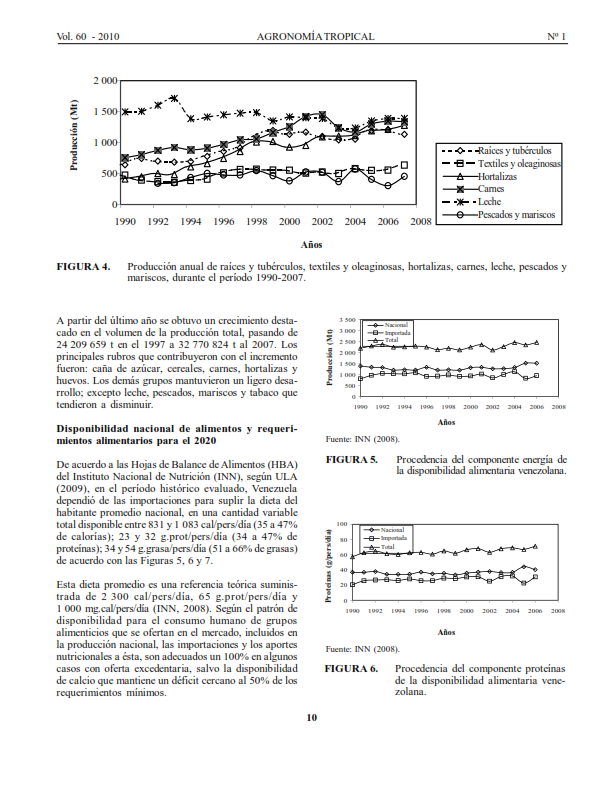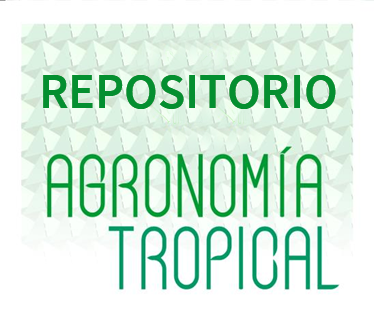Projection of the demand of agricultural earth in Venezuela, from the analysis of the nourishing needs to year 2020
Abstract
In the present work there has been calculated the necessary surface of agricultural lands to give the minimum food requirements of the Venezuelan population in 2020, from the design and optimization of a hypothetical diet that provides 3,001 calories/person/day, 91 g protein/person/ day, 88 g fat/person/day, 452 g carbohydrates/person/day and 942 mg calcium/person/day. From the dietetic designed formula, the quantity production needed and the corresponding harvested area, for each items and productive systems of the country, been calculated, under an approach of food self-sufficiency. The land demand was estimated for three possible scenarios of crop yield and the result was compared with the land's availability, to evaluate the agricultural land's availability/demand balance. They considered three scenarios were: productivity with the current rate of crops yields (2007), changes in crops yields based in historical trend and productivity based in maximum crops yields obtained in experimental regional essays. The historical trend was evaluated by linear regression analysis on each item's historical series. To satisfy the population food needs in 2020 there is needed approximately 55 million t of gross agricultural products to the year, which demands to harvest between 19 and 28 million ha, in agreement to the considered productivity scenarios. The land's general balance is positive, but when disaggregated, a significant deficit is observed in the systems High Floor Horticulture and Annual Mechanized Crops.
Downloads
References
• Centeno, J. 2009. El depredador de bosques. Fundación para el Desarrollo Sustentable [en línea]. [Consultado: 05 de Enero de 2009]. Disponible en: https://bit.ly/2PKJiVY
• Chacón, E., A. Baldizán y R. Torres. 2009. Sistemas de producción actuales y potenciales con bovinos en Venezuela. Convecar [en línea]. [Consultado: 30 de enero de 2009]. Disponible en: https://bit.ly/2VFsOSU
• Comerma, J., E. Casanova y V. Sevilla. 2005. Experiencias y perspectivas del uso de fertilizantes en pastizales en Venezuela. In: R. Romero; J. Salomón y J. De Venanzi (Ed.), XX Cursillo sobre bovinos de carne. Maracay: UCV-Facultad de Ciencias Veterinarias. 135-155 pp.
• Delahaye, O. 2003. La tierra en la agricultura venezolana. Algunos elementos para su caracterización. In: L. Albano; J. Rodríguez; L. Albano (Ed.), Elementos para el estudio del sistema agroalimentario venezolano. Maracay: UCV-Facultad de Agronomía. 1-33 pp.
• F E DE AGR O. 2 0 0 9 . E s t a dís t ica s Agr ícola s . FEDEAGRO [en línea]. [Consultado: 15 de enero de 2009]. Disponible en: https://bit.ly/38eLADi.
• Food and Agriculture Organization (FAO). 2009a. State of the World´s Forests 2009. Roma: Communication Division FAO. 152 p.
• Food and Agriculture Organization (FAO). 2009b. Crops. FAOSTAT [en línea]. [Consultado: 15 de enero de 2 0 0 9]. Disponible en: https://bit.ly/2PFX1gH.
• Food and Agriculture Organization (FAO). 2009c.Venezuela. AQUASTAT [en línea]. [Consultado: 17 de Enero de 2009]. Disponible en: https://bit.ly/2IgsimE.
• Food and Agriculture Organization (FAO). 2007a. Anuario Estadístico de la FAO-2004. Comercio Exterior [en línea]. [Consultado: 07 de enero de 2009]. Disponible en: https://bit.ly/39l9a2E.
• Food and Agriculture Organization (FAO). 2007b. State of the World´s Forests 2007. Roma: Communication Division FAO. 143 p.
• Food and Agriculture Organization (FAO). 2005. State of the World´s Forests 2005. Roma. Forestry Department. 153 p.
• Food and Agriculture Organization (FAO). 2003. State of the World´s Forests 2003. Roma. Forestry Department. 100 p.
• Food and Agriculture Organization (FAO). 2001. State of the World´s Forests 2001. Roma. Forestry Department. 175 p.
• Food and Agriculture Organization (FAO). 1999a. State of the World´s Forests 1999. Roma: FAO Information Division.
• Food and Agriculture Organization (FAO). 1997. State of the World´s Forests 1997. Oxford: Words and Publications.
• González, C. 1994. Utilización de la batata (Ipomoea batatas L.) en la alimentación de cerdos confinados y en pastoreo. Tesis Doctoral. Maracay, Ven. Universidad Central de Venezuela. Facultad de Agronomía. 234 p.
• Instituto Nacional de Estadística (INE). 2009. Censos de Población y Vivienda. Instituto Nacional de Estadística [en línea]. [Consultado: 20 de Enero de 2009]. Disponible en: https://bit.ly/38lJBgx.
• Instituto Nacional de Nutrición (INN). 2008. Hoja de Balance de Alimentos 2006. Caracas: Ministerio del Poder Popular para la Salud. 155 p.
• Marín, D. 2002. Rendimiento y producción agrícola vegetal: un análisis del entorno mundial (1997-1999) y de Venezuela (1988 -20 01). Agroalimentaria (15):49-73.
• Marín, R. 1999. Disponibilidad de tierras agrícolas de Venezuela. Caracas: Fundación Polar. 53 p.
• Ministerio de Agricultura y Cría (MAC). 1998. Resultados del VI Censo Agrícola 1997. Caracas: Dirección de Estadística e Informática.
• Ministerio de Agricultura y Tierras (MAT). 2007. Plan Integral de Desarrollo Agrícola 2007-2008. Nuevo modelo agrícola: Promoviendo el socialismo agrario. Caracas: MPPAT. 22 p.
• Montilla, J. 2004. La inseguridad alimentaria en Venezuela. Anales Venezolanos de Nutrición, 17(1):34-41.
• Montilla, J. 1992. Comercio mundial - autarquía alimentaria. VII Congreso Venezolano de Zootecnia. Maturín: Universidad de Oriente. 1-11 p.
• Montilla, J., D. Marín y M. Briceño. 2003. Agricultura: Base del Progreso. Caracas: PPOSU-Ministerio de Educación Superior. 119 p.
• Mora, E. y J. Rojas. 2007. Los cultivos líderes de la agricultura venezolana. Agroalimentaria (25):33-44.
• Organización de las Naciones Unidas para la Agricultura y la Alimentación (FAO). 1999b. Breve descripción de los recursos forestales de Venezuela. In: FAO-SIDA-CATIE (Ed.). Taller sobre el programa de evaluación de los recursos forestales en once países latinoamericanos, Documento de Trabajo 10. Turrialba, Costa Rica.
• Pacheco, G. 2003. La institucionalización de la investigación agrícola en Venezuela: Los primeros tiempos 1870-1935. Agroalimentaria (16):65-82.
• Rodríguez, A. 2007. Nuevas realidades, nuevos desafíos y nuevas tareas. Banco de Comercio Exterior, Alba Economía Año 1, N° 1 [en línea]. [Consultado: 29 de julio de 2009]. Disponible en: https://bit.ly/2x8ubzp.
• Rodríguez, J. 2003. El concepto de la combinación de recursos (tecnología). In: L. Albano, y J. Rodríguez. Elementos para el estudio del sistema agroalimentario venezolano. Maracay: UCV-Facultad de Agronomía. 1-32 pp.
• Scott, G., M. Rosegrant y C. Ringler. 2000. Raíces y tubérculos para el siglo 21. Tendencias, proyecciones y opciones de política. Washington-Lima: IFPRI- CIP. 64 p.
• Tejos, R. 2004. Alternativas de manejo de pastos tropicales introducidos en los llanos venezolanos. XII Congreso Venezolano de Producción e Industria Animal. Maracay: AVPA-ULA. 203-219 pp.
• Universidad de Los Andes (ULA). 2009. Hojas de Balance de Alimentos 1989-2006. Repositorio Institucional de la Universidad de Los Andes [en línea]. [Consultado: 03 de enero de 2009]. Disponible en: https://bit.ly/39nasKC.





